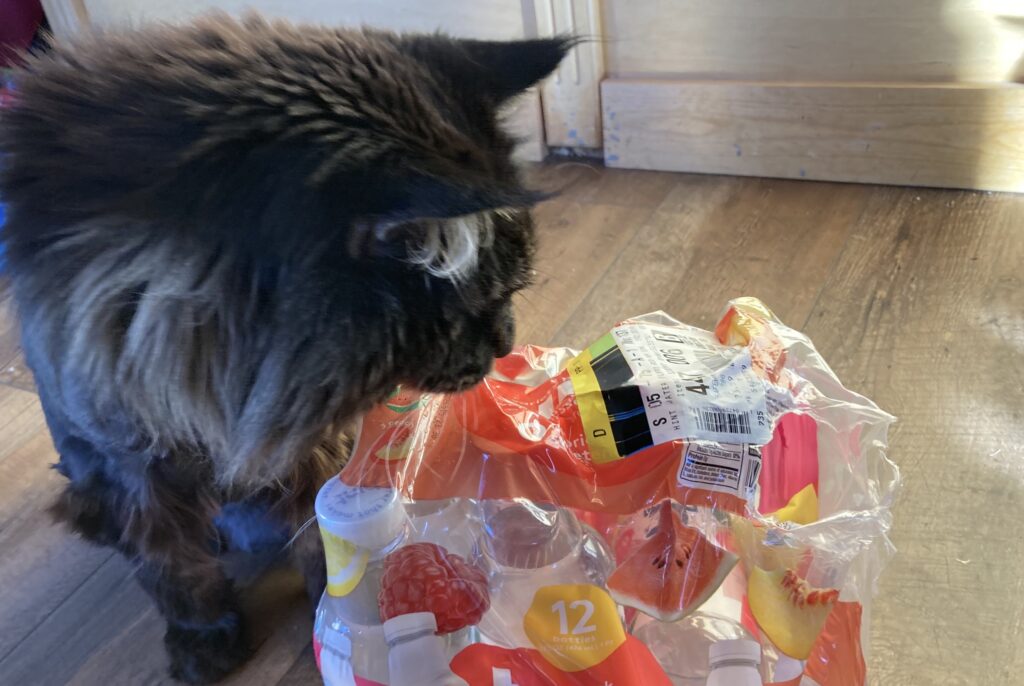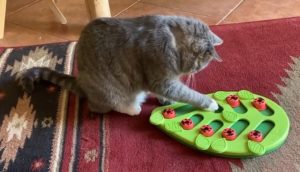 Have you had or do you have a cat who would eat anything – hair ties, ribbons, plastic – in addition to food? Have you experienced the anxiety waiting for your cat to pass whatever object you think he ate? It is not unheard of for cats to eat, chew or suck on non-food items. This behavior is called pica. How do you manage the cat with pica?
Have you had or do you have a cat who would eat anything – hair ties, ribbons, plastic – in addition to food? Have you experienced the anxiety waiting for your cat to pass whatever object you think he ate? It is not unheard of for cats to eat, chew or suck on non-food items. This behavior is called pica. How do you manage the cat with pica?
The Bristol Cat Study (Animals 2021, 11(4), 1101; https://doi.org/10.3390/ani11041101) followed a group of cats for a little over 3 years. To participate in the study, the owners had to own a kitten or kittens, 8-16 weeks old at the time of registration.
These owners were asked whether or not their cats chewed (with or without ingesting) one or more of the following items: 1) woolen fabrics 2) other fabrics 3) plastics 4) other materials. These questions were repeated at 2-4 months, 6.5-7 months, 12.5-13 months, and finally at 18.5-19 months. About 25% of 2203 cats were reported to exhibit some pica behavior.
Findings
- plastics were the most commonly targeted material
- pica was most commonly reported at 6.5-7 months of age
- about half of the cats reported to have pica at 6 months did not show pica at 18-19 months of age
- cats who moved to a new house when they were around year old were more likely to have pica
Managing the cat with pica
Pica can result in GI injury, poisoning, or electric shock. The goal of managing pica is to prevent injury to the cat.
Step one: Identify the material being targeted
Yarn? Thread? Hair Ties?
- yarn can wrap around the tongue
- thread may have a sharp needle attached
- hair ties
Poisons?
- Household chemicals: cleaners, antifreeze, insecticides, plant sprays
- House Plants: can be toxic – lilies in particular can cause kidney damage even in small amounts
Other?
- Filmy plastics and things like “fabric softener sheets”
- Chewing/biting electrical cords
- Kneading and sucking on blankets
- Chewing or sucking on toys
Step two: Keep targeted items out of reach of the cat with pica
- keep blankets and other fabrics in closets your cat can’t get into
- put hair ties and elastics away
- replace toys your cat may be eating with ones that he can’t eat
- supervise play times and access to toys
- cover electrical cords with plastic covers that cats can’t bite through
- unplug unused appliances
- discard or hang houseplants
- store household chemicals in a secure closet
Step three: Provide the cat with pica an alternative behavior
We would like to provide Kitty with an outlet for her oral activities and provide something safe for her to interact with.
 Keeping kitty busy
Keeping kitty busy
Try “free feeding” your cat with pica if possible. If “free-feeding” is not an option, frequent small meals will work. Food puzzles offer a natural cat behavior (foraging) as well as a snack. For some ideas, visit foodpuzzlesforcats.com.
Licking – a soothing behavior for cats
Slow-feeding mats are textured silicone mats that you spread canned food on. The cat licks the food off much like a wild cat may lick meat off a bone. Licking appears to be calming and soothing to cats. Some cats may like licking toys or balls made from compressed catnip.
Chewing
There are silicone toys that can be filled with catnip or silver vine (see the PetZone Boredom Buster dental chew toy). There is also a gum stimulator on the Catit Wellness Center that is designed to be chewed and sucked on. If you try these, be sure to monitor the wear on them and be around to supervise your kitty with these.
Cat Grass
Cats are attracted to grass and like to chew on it. There is the grass sold at pet stores and seeds you can plant. Some varieties of ornamental grasses are non-toxic to cats. Make sure to check the ASPCA site to make sure that the plants you choose are safe.
Step four: reducing stress in the cat with pica
Stress can stimulate an increase in pica behaviors, especially as cats grow out of the kitten stage. Identify and reduce stress whenever possible.
Social stress:
- How does the cat with pica get along with other pets in the household?
- Do neighborhood cats come to the windows?
- Are interactions with humans predictable?
Environmental stress:
- Have things changed in the home – furniture moved? Home remodeling?
- Changes in the scent profile of the home?
Managing the cat with pica can be challenging. Although the Bristol Cat Study indicated that half the cats who had been reported with pica at 6 months were no longer chewing/ingesting things at 18 months, it is wise to monitor your cat for such behavior, even if it seems to have gone away. Providing cats with safe opportunities to lick and chew is key to having a happy and healthy cat.
Your veterinary team is an important resource if you suspect your cat has pica. GI distress, oral pain and neurological issues can sometimes exacerbate pica and are best treated.


4cats2 says:
Thank you for sharing this article on managing a cat with pica. It’s important to address this behavior as it can lead to serious health issues for the cat. I appreciate the tips provided on identifying the cause of the behavior and implementing strategies to redirect the cat’s focus to more appropriate objects. I will definitely keep these in mind if my cat ever exhibits pica behavior. Thanks again for the helpful information!
lost life says:
Great tips! I never realized how important it was to keep certain items out of reach. My cat has been chewing on everything lately, and I’m definitely going to try some of these strategies. Thank you for sharing!
Tara says:
This is great, however in step one you do mention “Filmy plastics and things like “fabric softener sheets”” but in step 2 you do not mention how to address this.
For example, I have a cat that chews/eats the garbage bag edges while they are on the garbage cans, tape off of boxes we receive delivery from that she likes to sit in. She also chews and pulls apart the rug in my office.
For those needing ideas on how to deal with such items I have a few ideas, but none are free:
– I am getting a mat that looks like a rug so she can’t chew it (rubber type material), but getting one of sisal is an option so that the fibers won’t be long enough to tie up the intestines, but this may still cause issues (I am not sure if the broken off fibers would be sharp enough to perforate the feline internal workings).
– For disposal bags depending on the size of the bin one of the following is an option:
– bagless, or
– sourcing an eco-friendly bag option that doesn’t have harmful chemicals, or
– sourcing a biobag option (high price tag currently as not mass market purchased), or
– lastly using an air puff machine near the trash bins.
– For tape on shipping boxes, I haven’t found an amazing alternative yet, but removing it from the box, and then completing a cross fold works if you don’t want to pick the box up with the cat in it. Note – even the eco-friendly plastic free packing tape found on Amazon boxes has the threads through it and not knowing what is in those threads or how long they are in total it’s still hard for me to recommend this option for replacing the “Plastic” tapes.
I hope this helps to provided ideas to anyone else who have these particular issues.
felinepurrspective_u3q4o6 says:
Thanks for your comment, Tara!
Unfortunately filmy plastics and dryer sheets have to be kept out of the cat’s reach – recycle that film and put the cans/bottles away.
Ditto with dryer sheets – put the clean clothes away immediately. Some people switch to liquid fabric softener or store the sheets in a plastic container with a tight fitting lid (in a locked cupboard if necessary).
If she’s a real chewer, the sisal rug would not be a good choice – rug wise, try a floor mat (aka vinyl rug). They come in all sorts of patterns.
To deter the pica behavior, keep kitty busy: try meal feeding – food puzzles and lickimats to keep our girl happy; increase predatory play:
https://www.felinepurrspective.com/cats-playing-with-toys-predatory-play/
https://youtu.be/ONeOPvLP6cE?si=9rQfF-QnF82VzVAC
You can also try interrupting the behavior when you see it and redirecting the cat to something acceptable. https://youtu.be/iXBG6341pkU
Here is a link to a Veterinary Partner presentation tells you how your vet can help if things do not respond to vigilance and environmental enrichment. https://veterinarypartner.vin.com/apputil/project/defaultadv1.aspx?pid=24437&catid=&id=9382780&meta=&authorid=
A1 Lottery Game says:
Thank you for the helpful tips! I wasn’t aware that environmental enrichment could help with pica. I’ll definitely try incorporating more toys and interactive playtime for my cat. It’s so frustrating to see her eat non-food items. Your advice gives me hope!
bEt PkR says:
Great tips! I didn’t realize keeping the environment enriched could help so much. I’ll definitely try the distraction techniques you mentioned. Thanks for sharing!
Honista APK says:
Honista apk is a modified version of the Instagram app. It is designed for the users to provide more features than the Instagram app. It is the alternative to the official Instagram app which offers customization and privacy options. We can also download the photos and videos directly from the platform.